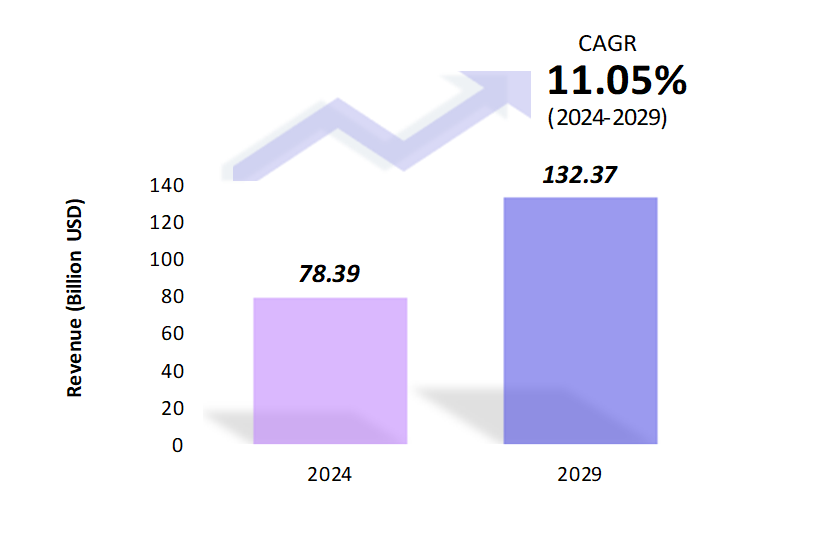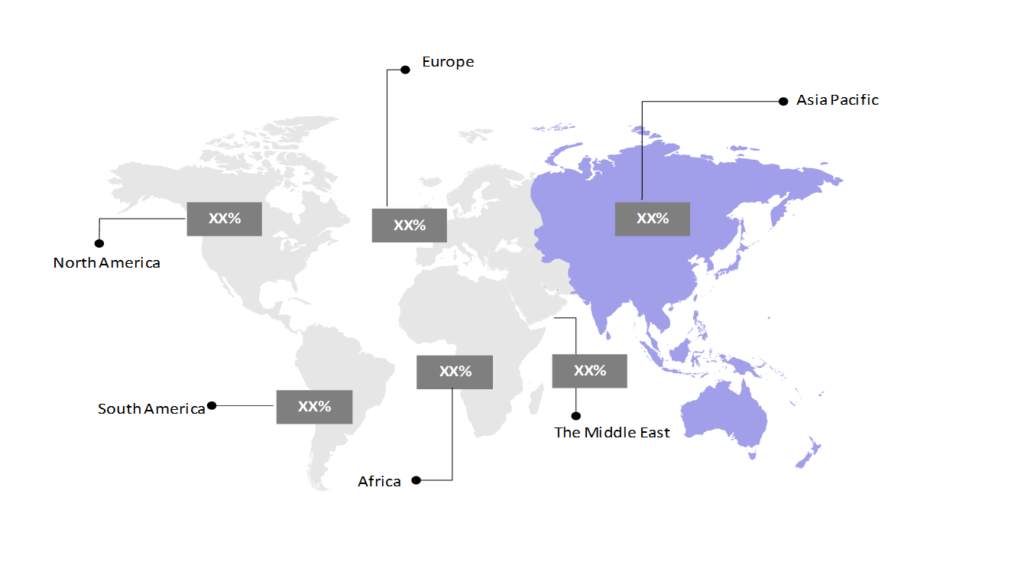Cloud Kitchen Market: Size, Share, Trends & Forecast (2024-2029)
The market report offers a detailed analysis segmented by Nature (Franchised, Standalone); by Type (Independent Cloud Kitchen, Commissary/Shared Kitchen, Kitchen Pods); by Geography (North America, South America, Asia Pacific, Europe, The Middle East, Africa).
Outlook

- The cloud kitchen market is estimated to be at USD 78.39 Bn in 2024 and is anticipated to reach USD 132.37 Bn in 2029.
- The cloud kitchen market is registering a CAGR of 11.05% during the forecast period of 2024-2029.
- The cloud kitchen market is rapidly expanding due to increasing consumer demand for convenience and efficient delivery-only models. Cost efficiency, lower overheads, and hectic lifestyles are driving growth of the market. As the sector evolves, it continues to attract investment and interest from both established players and new entrants.
Request a free sample.
Ecosystem

- The participants in the global cloud kitchen industry are always developing their strategies to preserve a competitive advantage.
- Companies with strong technological capabilities have a competitive edge in the cloud kitchen market. These players leverage data analytics, AI, and automation to optimize operations, reduce costs, and enhance customer experience.
- Several important entities in the cloud kitchen market include Zomato Ltd.; NEXEA Group Sdn Bhd; Doordash, Inc.; Rebel Foods Pvt. Ltd.; Ghost Kitchen Orlando; and others.
Ask for customization.
Findings
| Attributes | Values |
|---|---|
| Historical Period | 2018-2022 |
| Base Year | 2023 |
| Forecast Period | 2024-2029 |
| Market Size (2024) | USD 78.39 Bn |
| Market Size (2029) | USD 132.37 Bn |
| Growth Rate | 11.05% CAGR from 2024 to 2029 |
| Key Segments | Nature (Franchised, Standalone); Type (Independent Cloud Kitchen, Commissary/Shared Kitchen, Kitchen Pods); Geography (North America, South America, Asia Pacific, Europe, The Middle East, Africa) |
| Key Vendors | Zomato Ltd.; NEXEA Group Sdn Bhd; Doordash, Inc.; Rebel Foods Pvt. Ltd.; Ghost Kitchen Orlando |
| Key Countries | The US; Canada; Mexico; Brazil; Argentina; Colombia; Chile; China; India; Japan; South Korea; The UK; Germany; Italy; France; Spain; Turkey; UAE; Saudi Arabia; Egypt; South Africa |
| Largest Market | Asia Pacific |
Get a free quote.
Trends
- Collaborations and Co-working Spaces: Co-working kitchen spaces are becoming increasingly popular in the cloud kitchen market. These large, well-equipped kitchen infrastructures are designed to support multiple restaurant brands under one roof. Cloud kitchen operators can rent these shared spaces on a monthly basis or as needed, which allows for flexible operations.
- Robotic Process Automation (RPA) in Cloud Kitchens: A growing technological trend in the cloud kitchen market is the adoption of Robotic Process Automation (RPA). This technology is being increasingly preferred to streamline repetitive tasks, improve accuracy, and reduce labor costs, thus enhancing overall operational efficiency. For example, Spyce, a robotic kitchen in Boston, uses automated cooking robots to prepare meals with precision and speed.
- Increased Operational Flexibility: Cloud kitchens are increasingly using technology, such as POS software, to enhance operational flexibility. This technology allows restaurateurs to quickly introduce or remove menu items based on real-time demand. The digital nature of cloud kitchens ensures that the complete menu is always available and easily adjustable, enabling operators to experiment with new dishes, promotions, and pricing strategies with minimal disruption.
Speak to analyst.
Catalysts
- Increased Demand for Delivery-Only Models: The surge in online food delivery and evolving consumer preferences for convenience are fueling the growth of cloud kitchens. For example, Rebel Foods in India has achieved rapid expansion by operating exclusively through delivery channels. By leveraging the cloud kitchen model, Rebel Foods has efficiently scaled its operations across multiple cities, capitalizing on the growing demand for delivery-only dining experiences and expanding its reach without the constraints of physical restaurant locations.
- Cost Efficiency and Lower Overheads: Cloud kitchens significantly reduce operational costs by eliminating the need for traditional dining facilities. Kitchen United, a US-based company, exemplifies this model by offering shared kitchen spaces to various restaurant brands. This approach allows restaurants to lower their overhead expenses related to real estate, utilities, and front-of-house staff, focusing their resources on delivery operations.
- Hectic Lifestyles Driving Demand for Convenience: As modern lifestyles become increasingly hectic, consumers are seeking more convenient dining options, which is fueling the growth of the cloud kitchen market. Busy professionals, families, and individuals with demanding schedules are turning to delivery-only solutions for quick and easy meals. Cloud kitchens cater to this demand by providing efficient, on-demand food delivery services that fit seamlessly into fast-paced lifestyles, which allow consumers to enjoy quality meals without the need for time consuming trips to traditional restaurants.
Inquire before buying.
Restraints
- Solely Digital Presence: Cloud kitchens face challenges in building brand recognition and customer trust due to their online-only operation and limited physical interaction. This is particularly challenging when engaging older generations, who may be less comfortable with digital-only models. While younger, tech-savvy consumers are more easily reached, cloud kitchens must find effective strategies to build loyalty across all age groups.
- Hygiene Concerns: Maintaining high hygiene standards is crucial yet challenging as cloud kitchens scale. Some businesses attempt to cut costs by operating in unsanitary conditions, leading to concerns about food safety. Negative reports on social media about unsanitary practices can harm a cloud kitchen’s reputation and impact customer trust and satisfaction.
- Low-Profit Margins: While cloud kitchens benefit from reduced infrastructure and staffing costs, they face high aggregator fees from delivery platforms like Swiggy and Zomato, which take up to 30% of revenue. Since deliveries are their primary income source, these fees can erode profit margins, negating any savings from lower operational costs.
Personalize this research.
Hotspot

Explore purchase options.
Table of Contents
| 1. Introduction 1.1. Research Methodology 1.2. Scope of the Study 2. Market Overview / Executive Summary 2.1. Global Cloud Kitchen Market (2018 – 2022) 2.2. Global Cloud Kitchen Market (2023 – 2029) 3. Market Segmentation 3.1. Global Cloud Kitchen Market by Nature 3.1.1. Franchised 3.1.2. Standalone 3.2. Global Cloud Kitchen Market by Type 3.2.1. Independent Cloud Kitchen 3.2.2. Commissary/Shared Kitchen 3.2.3. Kitchen Pods 4. Regional Segmentation 4.1. North America 4.1.1. The US 4.1.2. Canada 4.1.3. Mexico 4.2. South America 4.2.1. Brazil 4.2.2. Argentina 4.2.3. Colombia 4.2.4. Chile 4.2.5. Rest of South America 4.3. Asia Pacific 4.3.1. China 4.3.2. India 4.3.3. Japan 4.3.4. South Korea 4.3.5. Rest of Asia Pacific 4.4. Europe 4.4.1. The UK 4.4.2. Germany 4.4.3. Italy 4.4.4. France 4.4.5. Spain 4.4.6. Rest of Europe 4.5. The Middle East 4.5.1. Turkey 4.5.2. UAE 4.5.3. Saudi Arabia 4.5.4. Rest of the Middle East 4.6. Africa 4.6.1. Egypt 4.6.2. South Africa 4.6.3. Rest of Africa 5. Value Chain Analysis of the Global Cloud Kitchen Market 6. Porter ‘s Five Forces Analysis 6.1. Threats of New Entrants 6.2. Threats of Substitutes 6.3. Bargaining Power of Buyers 6.4. Bargaining Power of Suppliers 6.5. Competition in the Industry 7. Trends, Drivers and Challenges Analysis 7.1. Market Trends 7.1.1. Market Trend 1 7.1.2. Market Trend 2 7.1.3. Market Trend 3 7.2. Market Drivers 7.2.1. Market Driver 1 7.2.2. Market Driver 2 7.2.3. Market Driver 3 7.3. Market Challenges 7.3.1. Market Challenge 1 7.3.2. Market Challenge 2 7.3.3. Market Challenge 3 8. Opportunities Analysis 8.1. Market Opportunity 1 8.2. Market Opportunity 2 8.3. Market Opportunity 3 9. Competitive Landscape 9.1. Zomato Ltd. 9.2. NEXEA Group Sdn Bhd 9.3. Door dash, Inc. 9.4. Rebel Foods Pvt. Ltd. 9.5. Ghost Kitchen Orlando 9.6. Company 6 9.7. Company 7 9.8. Company 8 9.9. Company 9 9.10. Company 10 |
Know the research methodology.
Cloud Kitchen Market – FAQs
1. What is the current size of the cloud kitchen market?
Ans. In 2024, the cloud kitchen market size is USD 78.39 Bn.
2. Who are the major vendors in the cloud kitchen market?
Ans. The major vendors in the cloud kitchen market are Zomato Ltd.; NEXEA Group Sdn Bhd; Door dash, Inc.; Rebel Foods Pvt. Ltd.; Ghost Kitchen Orlando.
3. Which segments are covered under the cloud kitchen market segments analysis?
Ans. The cloud kitchen market report offers in-depth insights into Nature, Type, and Geography.
